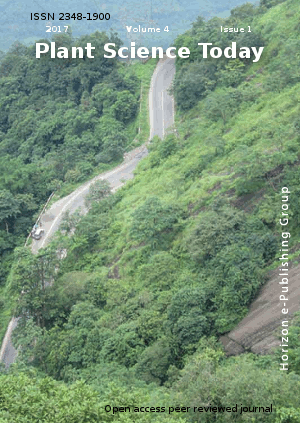Ethnobotanical plants of Veligonda Hills, Southern Eastern Ghats, Andhra Pradesh, India
DOI:
https://doi.org/10.14719/pst.2017.4.1.268Keywords:
Ethnobotany, Threatened, Endangered, Endemic, Veligonda hill rangeAbstract
The Veligonda range which separates the Nellore district from Kadapa and Kurnool is the back bone of the Eastern Ghats, starting from Nagari promontory in Chittoor district. It runs in a northerly direction along the western boarders of the Nellore district, raising elevation of 3,626 feet at Penchalakona in Rapur thaluk. Veligonda hill ranges have high alttudinal and deep valley. These hills have rich biodiversity and many rare, endangered, endemic and threatned plants are habituated in these hills. The present paper mainly deals with the ethanobotanical plants used by local people.Downloads
References
Andhra Pradesh State of Forest Report. 2013. Government of Andhra Pradesh.
Champion, H. G. and S. K. Seth. 1968. A Revised Survey of the Forest types of India. Government of India, New Delhi.
Gamble, J. S. 1915-36. Flora of Presidency of Madras. Adlard and Son Lrs Lonswn 1, 55.
Karve, Irawati. 1968. Hindu Society: An interpretation, 2nd edn. Deshmuk prakashan, Poona.
Nair, M. P. and A. R. K, Sastry. 1998. Red Data Book of Indian Plants. BSI Publications.
Raghavaiah V, 1962. The Yanadis, New Delhi, India; Adimjati Sevak Sangh.
Ranga Rao, T. R. 1901. The Yanadis of Nellore district. Bull. Madras Govt. Museum IV (2): 87-113.
Downloads
Published
How to Cite
Issue
Section
License
Copyright and Licence details of published articles
Authors who publish with this journal agree to the following terms:
- Authors retain copyright and grant the journal right of first publication with the work simultaneously licensed under a Creative Commons Attribution License that allows others to share the work with an acknowledgement of the work's authorship and initial publication in this journal.
- Authors are able to enter into separate, additional contractual arrangements for the non-exclusive distribution of the journal's published version of the work (e.g., post it to an institutional repository or publish it in a book), with an acknowledgement of its initial publication in this journal.
Open Access Policy
Plant Science Today is an open access journal. There is no registration required to read any article. All published articles are distributed under the terms of the Creative Commons Attribution License (CC Attribution 4.0), which permits unrestricted use, distribution, and reproduction in any medium, provided the original author and source are credited (https://creativecommons.org/licenses/by/4.0/). Authors are permitted and encouraged to post their work online (e.g., in institutional repositories or on their website) prior to and during the submission process, as it can lead to productive exchanges, as well as earlier and greater citation of published work (See The Effect of Open Access).










